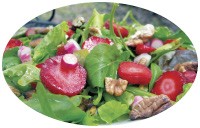If you’ve heard of farm-to-table, you’ve heard of Michael Pollan. Along with Alice Waters, he practically invented the movement. In books like The Omnivore’s Dilemma and In Defense of Food, Pollan showed readers the horrors of industrial food systems and advocated a return to traditional, local, and sustainable fare.
Like many aspiring locavores, I read and I cheered. But Pollan was hiding something from his fellow foodies. He didn’t really know how to cook. In his own words: “It’s not like I was a total novice. I mostly grilled. I would marinate expensive filets and throw them on the grill.”
In Cooked: A Natural History of Transformation, Pollan’s new book, the author finally learns to make his own supper. In the process, he takes readers on a mouthwatering journey across the United States, learning to barbecue a whole hog in North Carolina and make sauerkraut in California. The Flyer recently caught up with Pollan to chat about microbes, complex carbohydrates, and good, old-fashioned barbecue.
Flyer: Americans spend just 27 minutes per day cooking. How did we get here?

Michael Pollan
Michael Pollan: A lot of reasons. One of them is changing lifestyles. Now you have both men and women working, so you don’t have someone in the home who could be cooking. And rather than develop a new division of labor around cooking, families have invited food corporations into our lives to cook for us. And that’s something the industry has been wanting to do for a long time.
Is the way we eat now making us sick?
Oh, absolutely. Four out of the top-10 killers today are chronic diseases linked to the way we eat. We spend about a trillion dollars a year on health-care costs linked to diet. Just an example: We struggle with very high rates of Type 2 diabetes — 8 percent and soaring. So when you hear the words “health-care crisis,” what you should hear is “the Western diet.”
Why is cooking so important?
The short answer is that it’s only by cooking that we can control the amount of sugar, fat, and salt in our diet. We just can’t count on companies to do that in a responsible way. But that’s hardly doing it justice. There’s the intellectual stimulation, the sensory stimulation. The social dimension. The family meal correlates with so many positive markers: not just nutritional health, but things like success at school and drug use.
All right, I’m coming to dinner. What are you cooking?
Ha. If a guest were coming over? I’d buy a chicken and brine it. The brine would be a mix of salt, sugar, and spices. And some garlic and lemon peel. Then I’d slow-grill it at about 250 degrees for an hour and 15 minutes. That way the skin would be all crinkly and brown and delicious.
Let’s talk microbes. Why should we embrace things like yeast and bacteria?
What we’ve learned is that there is an ecosystem in your large intestine consisting of trillions of microbes. Mostly bacteria. And these bacteria are key not just to digestion, but to things like your immune system and your mental health. The thing is, you’ve got to feed them! Taking care of that ecosystem turns out to be a very important part of your health.
Wow. That’s kind of gross and kind of awesome. What should we feed them?
The thing is, these microbes don’t actually like the Western diet very much. Most of what Americans eat — things like sugars and fats — are absorbed in the small intestine. But these microbes live farther down, in the large intestine. If you want to make it down there, you’ve got to eat complex carbohydrates: plant fiber in all its various forms. Bananas and oats and onions and nuts and avocados.
Memphis is a barbecue town. Can you offer any tips for backyard barbecuing?
Slow down. Most people cook barbecue too fast. Great barbecue is cooked very slowly. Part of that is learning how to control the temperature. If you’re using coals, you really have to wait for them to burn down before you put food on. Then you can add one or two coals every now and then. You really want to be close to 200, 250 degrees. If you’re over 300, you’re not barbecuing, you’re grilling.
 by Bianca Phillips
by Bianca Phillips